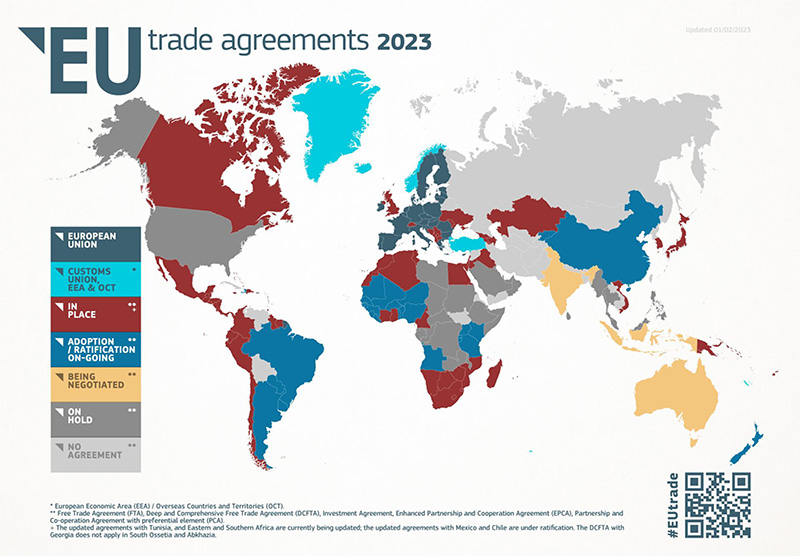The EU negotiates trade agreements on behalf of the member states – including Ireland. These agreements deal with preferential duty rates on the shipment of goods between the EU and countries around the world.
They have also evolved to cover a wider range of areas to facilitate trade. Among these include government procurement opportunities, business visitor visas, mutual recognition of professional qualifications, the certification of products, intellectual property rights and the cross border trade in services.
These far reaching agreements can take a number of years of detailed negotiations.
The EU has preferential trade agreements with about 70 countries worldwide.[1] These countries represent nearly 32% of the EU’s external trade.[2]
€3 billion worth of Irish exports are eligible for preferential tariffs as a result of these agreements.[3]

There are a number of negotiations ongoing with countries in the hope that a future free trade agreement can be reached. Some of the more significant include Australia, New Zealand and Mercosur (Brazil, Argentina, Uruguay, Paraguay)
Further information on EU Free Trade Agreements
EU-Vietnam Free Trade Agreement
In 2019 the European Union and Vietnam agreed a Free Trade Agreement. The trade agreement covers a range of goods and services. The agreements sees significant tariffs reductions on food and beverage items as well as tackling a number of non tariff barriers. The agreement also includes commitments in the areas of international labour rights and protections, global environmental agreements and human rights.
Vietnam is an exciting Asian economy. Its GDP has been one of the fastest growing in the world over the past several years. This is powered by a large, youthful population. Reflecting the increased business potential, Enterprise Ireland has recently opened an office in Vietnam for the first time.
EU-Vietnam’s Free Trade Agreement—what it means for Irish exporters
Further information on the EU-Vietnam Economic Partnership Agreement
EU-Japan Economic Partnership Agreement (EPA)
The European Union and Japan have signed the Economic Partnership Agreement, a comprehensive trade agreement including goods, services and investment, eliminating tariffs, non-tariff barriers and other trade-related issues, such as public procurement, regulatory issues, competition, and sustainable development.
Japan is one of the key trading partners of the European Union, it is its seventh largest trading partner globally and the second biggest one in Asia. Conversely, the European Union is Japan’s third largest trading partner. Together economies of Japan and the EU account for more than one third of world GDP.
The EPA applies as of 1 February 2019.
EU-Japan Economic Partnership Agreement—what it means for Irish exporters
EU-Japan Economic Partnership Agreement infographic
Further information on the EU-Japan Economic Partnership Agreement
EU-Canada – Comprehensive Economic Trade Agreement (CETA)
CETA was signed on 21 October 2017. The benefits related to tariffs are in force. CETA was the first of the new generation of trade agreements signed by the EU.
EU-Canada – Comprehensive Economic Trade Agreement (CETA)
EU-Canada Comprehensive Economic Trade Agreement—what it means for Irish exporters
EU-Canada – Comprehensive Economic Trade Agreement infographic
EU-Singapore Free Trade Agreement
In October 2018, the EU and Singapore signed a Free Trade Agreement and Investment Protection Agreement (IPA). The EU-Singapore FTA is the first FTA between the EU and a member of the Association of South East Asian Nations (ASEAN). This Agreement entered into force on 21 November 2019.
EU-Singapore Free Trade Agreement—what it means for Irish exporters
Further information on the EU-Singapore Economic Partnership Agreement
Modernisation of the EU-Mexico Global Agreement
This has been agreed in principle with some outstanding technical issues being finalised during 2019.
Modernisation of the EU-Mexico Global Agreement
[1] trade.ec.europa.eu/doclib/press/index.cfm?id=1933
[2] trade.ec.europa.eu/doclib/docs/2018/october/tradoc_157468.pdf
[3] EU EXPORTS, PREFERENCES UTILISATION AND DUTY SAVINGS BY MEMBER STATE, SECTOR AND PARTNER COUNTRY
Lars Nilsson and Nicolas Preillon